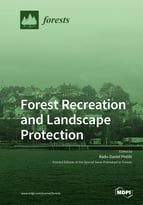Forest Recreation and Landscape Protection
A special issue of Forests (ISSN 1999-4907). This special issue belongs to the section "Forest Economics, Policy, and Social Science".
Deadline for manuscript submissions: closed (31 July 2022) | Viewed by 28340
Special Issue Editor
Interests: forests; land use and land cover; tourism; GIS
Special Issues, Collections and Topics in MDPI journals
Special Issue Information
Dear Colleagues,
Forest, as an important natural resource, is constantly threatened with extinction. Forest recreation and landscape protection are two of the main pillars of the environment, and in the last century they became important activities for people. Forest recreation focuses on forest as a main destination for public recreational activities from many points of view, and landscape protection refers to the conservation, development, and restoration of the functionality of natural beauties so that they are perfectly balanced by nature. Landscape protection also refers, to the capacity of natural resources to regenerate themselves and sustain the inner development of human settlements. Urban and peri-urban forests became a real place for recreational activities of the population living in the big cities of the world. In some countries, even the seasonal collection of berries and mushrooms, integrated as a rural life, are social activities. Nowadays, the demands for forest recreation activities have been increasing, both in their volume and diversity. Additionally, landscape protection has been imposed, in the last two or three decades, by the massive human aggression on all its components. The landscape protection is imposed too, not only for scientific ecologic reasons, but also for social and cultural ones, and that is why the driving mechanisms for managing future forests should be better understood. So, we encourage studies from all fields, to contribute to this Special Issue in order to promote knowledge and adaptation strategies for an efficient intersection of forests exploitation and conservation (forest management).
Dr. Radu-Daniel Pintilii
Guest Editor
Manuscript Submission Information
Manuscripts should be submitted online at www.mdpi.com by registering and logging in to this website. Once you are registered, click here to go to the submission form. Manuscripts can be submitted until the deadline. All submissions that pass pre-check are peer-reviewed. Accepted papers will be published continuously in the journal (as soon as accepted) and will be listed together on the special issue website. Research articles, review articles as well as short communications are invited. For planned papers, a title and short abstract (about 100 words) can be sent to the Editorial Office for announcement on this website.
Submitted manuscripts should not have been published previously, nor be under consideration for publication elsewhere (except conference proceedings papers). All manuscripts are thoroughly refereed through a single-blind peer-review process. A guide for authors and other relevant information for submission of manuscripts is available on the Instructions for Authors page. Forests is an international peer-reviewed open access monthly journal published by MDPI.
Please visit the Instructions for Authors page before submitting a manuscript. The Article Processing Charge (APC) for publication in this open access journal is 2600 CHF (Swiss Francs). Submitted papers should be well formatted and use good English. Authors may use MDPI's English editing service prior to publication or during author revisions.
Keywords
- forest disturbances
- biodiversity
- forest recreation
- ecosystem services
- forest regeneration
- forest management
- landscape conservation
- landscape disturbance






